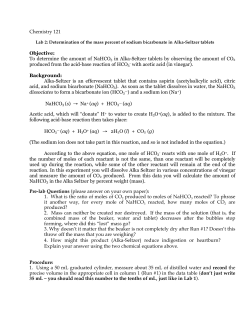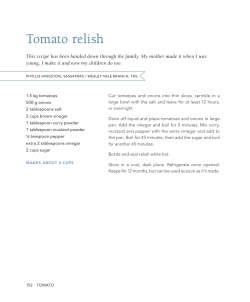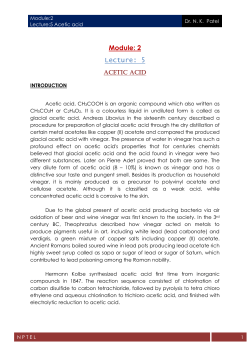
LIMITING REACTANT AND MASS PERCENT OF NaHCO IN ALKA-SELTZER
LIMITING REACTANT AND MASS PERCENT OF NaHCO3 IN ALKA-SELTZER Adapted from “Journal of Chemical Education” Vol. 79, No. 7, July 2002 http://jchemed.chem.wisc.edu/Journal/Issues/2002/Jul/abs848.html Background: The extent of a chemical reaction is determined by the amount of reacting materials, or reactants, present in the reacting system. Reagents are generally not mixed in exact amounts needed for the reaction to take place, there is usually one of the reacting materials added in excess. The excess reagent, usually a non-critical reagent or an inexpensive material, is used to insure that all of the critical reagent is used up so that there will be a maximum amount of product formed. Also, an excess of one reactant can cause the overall reaction to take place at a faster rate. Once the critical reactant is used up, the reaction will stop. That critical reactant is called the limiting reagent, that is, it is the reactant in the chemical reaction that is used up first. In this lab you will be using Alka-Seltzer tablets to investigate limiting reactants. A quote from Alka-Seltzer’s website (http://www.alka-seltzer.com/as/as.htm): “The effervescent form is what makes Alka-Seltzer® special… Alka-Seltzer is a different kind of medicine because you can see, hear and feel it working. With the active and lively bubbles, Alka-Seltzer® speeds relief.” If the weight loss resulting from the release of these “active and lively bubbles” is quantified, the amount of NaHCO3 initially present in an Alka-Seltzer tablet can be determined. An Alka-Seltzer tablet contains 1916 mg sodium bicarbonate (NaHCO3), 325 mg acetylsalicylic acid (HC9H7O4), and 1000 mg citric acid (H3C6H5O7 ). Once the tablet is dissolved in water, sodium bicarbonate reacts with the acetylsalicylic and citric acid: 2 NaHCO3(s) + HC9H7O4 (s) + H3C6H5O7 (s) 2 H2CO3 (aq) + NaHC9H7O4 (aq) + NaH2C6H5O7 (aq) Carbonic acid is unstable and quickly decomposes into water and carbon dioxide gas (the “active and lively bubbles”): H2CO3(aq) H2O(l) + CO2(g) However, some sodium bicarbonate is left unreacted. This excess NaHCO3 is available to neutralize stomach acids responsible for indigestion, sour stomach, and/or heartburn. In the laboratory, vinegar (acetic acid, HC2H3O2) can be used in place of the stomach acids to react with the remaining sodium bicarbonate: HC2H3O2(aq) + NaHCO3(aq) NaC2H3O2(aq) + H2CO3(aq) The carbonic acid produced in this reaction decomposes as before (see equation above). In this experiment, Alka-Seltzer tablets will be added to 8 solutions with increasing amounts of vinegar. The amount of carbon dioxide produced by the reaction of sodium bicarbonate with acetylsalicylic, citric, and acetic acid will be determined by massing the reaction components (beaker, solution, and tablet) before and after the evolution of CO2 gas. Stoichiometric calculations will then be performed to determine the mass of NaHCO3 reacted in each trial and to identify the limiting reactant. A plot of mass % NaHCO3 vs. vinegar volume will be used to experimentally determine the total amount of NaHCO3 in an Alka-Seltzer tablet. Safety: Safety goggles and aprons must be worn at all times. After the experiment, all solutions can be diluted with water and dumped in the sink. Do not eat the reactants (vinegar and Alka-Seltzer) as they may be contaminated with other laboratory chemicals. Methods: A. Materials: - 8 tablets, Alka Seltzer Tablets (Bayer Corporation) or generic equivalent - Acetic acid, 4.5 to 5% (vinegar) - 2 250 mL beakers - 2 10 mL graduated cylinders - 50 mL graduated cylinder - glass stirring rod B. Procedures: 1. Measure 35 mL of distilled water into a 250 mL beaker. Weigh the beaker and water and record the mass. 2. Weigh and record the mass of an Alka Seltzer tablet. 3. Place the Alka Seltzer tablet into the water in the 250 mL beaker. When the bubbling has ceased, stir the solution to ensure complete dissolution of the tablet and to remove any visible bubbles of carbon dioxide. Gently tap the stirring rod against the inside of the beaker to remove any drops of liquid before weighing the beaker and its contents. 4. Weigh the beaker and its contents. Record the mass. 5. Dispose of the solution in the beaker as instructed. Wash the beaker and rinse it with distilled or deionized water. 6. Repeat the experiment using 5 mL of acetic acid (vinegar) and 30 mL of water in the 250 mL beaker. NOTE: once the reaction has started, you may use a second 250-mL beaker to run the next trial in the experiment. You can continue to alternate beakers, running the additional experiments in simultaneous, but staggered trials. Be sure to keep track of the mass of each beaker used, as the exact mass of each beaker is different. 7. Repeat the experiment a third time using 10 mL acetic acid (vinegar) and 25 mL of water in the 250 mL beaker. Continue to repeat the experiment 5 more times increasing the volume of the acetic acid by 5 mL and decreasing the volume of water by 5 mL for each new trial as indicated in Table 1. Table 1. Composition of Reaction Solutions Experiment No. 1 2 3 4 5 6 7 Volume of Acetic Acid (mL) 0 5 10 15 20 25 30 Volume of Water (mL) 35 30 25 20 15 10 5 8 35 0 Results: Present all data in a neatly organized table. For each trial (1-8), record the following in your table: 1. Volume of acetic acid (mL) 2. Volume of water (mL) 3. Mass of beaker and liquid (g) 4. Mass of Alka-Seltzer tablet (g) 5. Total mass of beaker and contents before reaction (g) 6. Total mass of beaker and contents after reaction (g) 7. *** Mass of CO2 8. *** Mass of NaHCO3 9. *** Mass Percent of NaHCO3 *** CALCULATIONS: - Show all work and record final values for each trial in your data table. 1. Determine the mass of CO2 lost from each beaker due to gas evolution. Show all work and record final values in data table. 2. Using the balanced equations from the introduction, determine the mass of NaHCO 3 reacted from each Alka-Seltzer tablet from the mass of CO2 lost. 3. Find the mass percent of NaHCO3 reacted from each Alka-Seltzer tablet. *** GRAPH: - Using a computer graphing program, plot the mass percent of NaHCO3 on the y-axis versus the volume of acetic acid on the x-axis. Print this graph and turn it in with your lab report. Analysis: - Answer the following questions: 1. This reaction only requires 35 mL of liquid. Why is it important to run the reaction in such a large (250-mL) beaker? 2. What is the minimum volume of vinegar required to react with all of the NaHCO3 present in an Alka-Seltzer tablet? Briefly describe the basis for your choice. 3. Use your graph to determine the limiting reactant. Explain your answer. 4. Using the theoretical mass of sodium bicarbonate that was given in the introduction, calculate the percent error. Consider: which value will you use for your experimental mass? You may have had a different mass for each trial. Which should you use? Be sure to justify your decision. Conclusion: 1. Written summary of lab, including key results. 2. Error analysis summary. Account for your calculated percent error.
© Copyright 2025


















